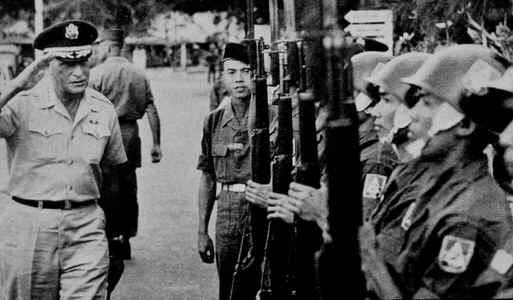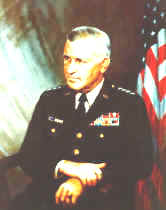 |
| Category: The Leaders |

|
|
|
|
|
|
"By Christmas it will be
all over". (American
General Paul Harkins,
April 1963) |
|

|
1961
- Ngo Dinh Diem anti-communist, pro-U.S.
in south; Ho Chi Minh pro-USSR in north
- National Liberation Front organized
in south Dec. 20, 1960, by anti-Diem groups
- infiltration from north began 1961,
communist People's Revolutionary Party gained leadership of NLF by
1962
- JFK sought "limited
partnership" with Diem, flexible response, counter-insurgency,
nation-building, reform without revolution
- CIA recruited Meo (Hmong) tribesmen
in Laos, Montagnards in Central Highlands to fight Pathet Lao and
Viet Minh
- Maxwell Taylor and Green Berets May
1961
- Operation Ranch Hand Nov. 1961 -
18m gals herbicides (2/3 was Agent Orange) on 8% land area by 1971
1962
- MAAG (Truman's Military Advisory
and Assistance Group) replaced by MACV (Military Assistance Command,
Vietnam) Feb. 12, 1962, under Gen. Paul Harkins and Project Beef-Up
- 11300 advisors sent during 1962, with 300 aircraft, automatic
rifles, napalm, penicillin - 16000 advisors by Nov. 1963
- Operation Sunrise - strategic
hamlet program - 6800 built by Nov. 1963
- Texas group awarded $2b to
construct bases at Saigon, Danang, Cam Ranh Bay, Qui Nonh
1963
- Battle of Ap Bac Jan. 2, 1963 in
Mekong Delta - 350 VC attacked by 2 ARVN battalions with 5 new
HU-1 Iroquois helicopters, but ARVN reluctant to fight, all
helicopters shot down, 3 U.S. pilots killed - Lt. Col. John Vann led
13 M113 armoured personnel carriers into village after ARVN refused
to advance - battle revealed weakness of popular support for the
Diem Catholic urban mercantile elite government that had abolished
the village electoral system in 1956, failed to implement land
reform, followed anti-Buddhist repression
- JFK State of Union speech Jan. 14
declared that "aggression blunted in Vietnam"
- JCS sent investigation team Jan. 18
- Joe Mendenhall said VC getting stronger
- infiltration from NV grew from 850
per month to 1700 per month, with new Russian heavy weapons imported
by fishing boats - 81mm mortars with 2-mile range, 75mm recoiless
rifle - launched major offensive in Delta that destroyed strategic
hamlets and captured 200,000 U.S. weapons by Nov.
- Buddhist riots May 8 led by Tri
Quang - Diem's troops fired into Buddhist crowd and killed 8 -
immolation suicide of Quang Duc June 11
- Diem assault on Buddhist pagodas
Aug. 20 - martial law - 1400 arrested
- JFK feared that the U.S. would
"lose" Vietnam like Truman lost China in '49 - replaced
Nolting with new ambassador Henry Cabot Lodge in Aug. - Rusk cable
to Lodge Aug. 24 to encourage SV generals planning coup to overthrow
Diem - JFK approved on Oct 5 the selective suspension of aid to Diem
- Rusk cable to Lodge Oct. 6 "while we do not wish to stimulate
a coup," the U.S. would support a more popular government -
Diem assassinated Nov. 2
- JFK approved on Nov 20 McNamara's
Plan 34A, covert operations in NV including commando raids,
kidnapping, mercenaries, parachute sabotage teams, U.S. Navy
intelligence-gathering DeSoto patrols
- JFK assassinated in Dallas Nov. 22
|
|
|
Gen. William Westmoreland
Born 1914.
Graduated West Point 1936
Served with distinction in WWII
Superintendent West Point in 1960
Commander US Military Assistance Command, Vietnam (MACV) 1964-1968.
General Westmoreland took command in Vietnam in June 1964 replacing Gen.
Paul Harkins. He was instrumental in raising the level of US forces
deployed in Vietnam and in developing the strategies implemented in the
region. |
Westmoreland continuously requested for an increase in manpower
in Vietnam and President Johnson, who had his own troubles at home,
refused to send more troops and finally recalled Westmoreland after he
successfully stopped the North Vietnamese Tet Offensive in 1968. He was
replaced by General Creighton W. Abrams
Upon his return to the US, Westmoreland was appointed as Chief of Staff
of the US Army. His biggest challenge was to withdraw the troops from
Vietnam and ready them for duty in other regions of the world. He was
successful in restructuring the Army at a difficult time, but his
tactics in Vietnam had become unpopular with some groups in the US. He
maintained for many years that the policy in Vietnam had been the right
one. General Westmoreland retired in 1972. |
 |
Creighton
Williams Abrams, Jr.
General, United States Army
|
|
He
was promoted to first lieutenant, June 1939, and to temporary captain,
September 1940; was briefly a tank company commander in the 1st Armoured
Division, 1941; was a battalion commander in the 37th Armoured Regiment,
1942–1943; was promoted to temporary major (February) and lieutenant
colonel (September), 1943; commanded the 37th Tank Battalion and Combat
Command B, 4th Armoured Division, in Allied operations across Europe,
1943–1945; was promoted to temporary colonel, April 1945; served on
the Army General Staff, 1945
A veteran of
three wars, General Abrams rose to the Army's highest leadership
position because he was pre-eminently a leader and commander of troops,
particularly in wartime. From platoon to corps, he commanded at every
Level and finally served as Joint Commander of all U.S. Forces in
Vietnam. Commissioned in the Cavalry in 1936, General Abrams served
initially with various cavalry and tank units of the 1st Cavalry
Division and the 1st Armoured Division. Joining the newly activated 4th Armoured
Division in 1941, he remained with the Division throughout World War II.
As a battalion commander, and then combat command commander, he
participated in every campaign the Division fought and became widely
known as one of the Army's most aggressive and successful Armour
commanders.
It was
Lieutenant Colonel Abrams, in a conference on the banks of the Moselle,
who pointed east and remarked: "That is the shortest way
home." It was a tank unit called Task Force "Abe" that
led the thrust across the Moselle; it was a
tank unit commanded by Abrams that broke the German encirclement at
Bastogne in the Battle of the Bulge. It
was Abrams' unit that tore from Bitburg to the Rhine including an attack
of over forty miles in less than two days. Time and time again Abrams
led the thrust across the German homeland and into Czechoslovakia, often
at the head of the column. His World War II commander, General
George S. Patton, Jr., once said: "I'm supposed to be the best tank
commander in the Army but I have one peer - Abe Abrams. He's the world
champion."
During the
Korean War, General Abrams served successively as Chief of Staff of I,
IX and X Corps. He participated in the defence against the last major
Communist offensives of the war. He remained to help set up I Corps as a
key link in the United Nations Command organization.
Following his
duty in Korea, General Abrams served for a period as Chief of Staff of
the Armour Centre at Fort Knox, Kentucky. Returning to Europe in 1959,
he was assigned as Assistant Division Commander, 3d Armoured Division,
and later as Commanding General of the Division. After another tour in
Washington and yet another in Europe, this time as a Corps Commander, he
received his fourth star and was selected as the Army's Vice Chief of
Staff.
In 1967, he
became Deputy Commander of the U.S. Military Assistance Command,
Vietnam; a year later, he was appointed its Commander. For the four
years General Abrams commanded in Vietnam, it was his task to reduce
direct U.S. military involvement and to transfer increasing defence
responsibilities to Vietnamese forces, as they became capable of
assuming them. By the time he left Vietnam in 1972, that job had
been virtually completed.
After his
extensive service in Vietnam, General Abrams was nominated to be Chief
of Staff, United States Army, and was confirmed by the Senate on October
12, 1972. Since that day, General Abrams' principal challenge was to
knit together an Army that had suffered the double trauma of rapid
reduction in size and massive repositioning of forces, both occasioned
by the end of U.S. military operations in Vietnam. To add to the
challenge, it was during this same period that authority for induction
ended, and the Army shifted to an all-volunteer footing.
The
major themes in the Army during those two years were Abrams themes, as
plain and strong as the man who established them: the readiness mission;
rethinking the Army's role; and taking care of the soldier. The actions
that flowed from this guidance increased the readiness and effectiveness
of the Army dramatically. At the same time, morale improved and
disciplinary problems subsided, responding to the firm hand at the top.
Just prior to his being stricken by lung cancer, General Abrams had set
in motion a program to increase markedly the Army's combat capability
without increasing its total strength. It was to be done the Abrams way,
by cutting out entire headquarters, by making other headquarters -
including his own - much smaller, and by making every element in the
Army count toward the overall mission. |
|
